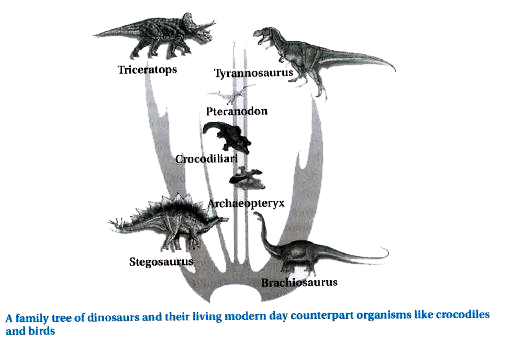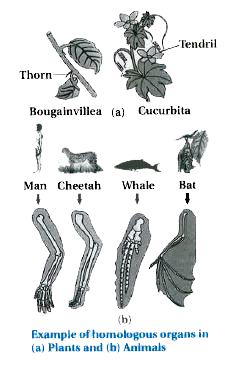How does paleontology, comparative anatomy and morphology help in study of evolution.
Text Solution
Evidences that evolution of life forms has indeed taken places on earth has come from many quarters.
Paleontological evidences: Paleontology is the study of fossils (Le. remains of hard parts of life forms found in rocks.)
Rocks form sediments and a cross-section of the earth. scrust depicts the arrangement of these sediments one over the other, during the long history of earth.
Sediments of different aged rocks contain fossils of different life forms that lived and died during the formation of a particular segments.
Some of them appear similar to modern organism. They represent extinct organisms like dinosaurs.
The study of fossil in different sedimentary layers indicates the geological period in which they existed.
It also shows that the life forms varied over times and certain life forms are restricted to certain geological time scale.
Hence new forms of life have evolved at different time in the history of earth.
All this is called paleontology evidence.

The age of these fossils are estimated by using methods like radiocarbon dating.
Comparative Anatomy and Morphological evidences: These show the similarities and differences among the organisms of today and those that existed year ago.
These evidences come from the comparative study of external and internal structure.
These can be determined by the following types.
Homology: It is the relation among the organ of different groups of organisms, that show similarity on the basic structure and embryonic development but have different function.
Homology in organs indicates common ancestry.
It is based on divergent evolution.
When due to different needs, some structures develop differently the condition is called divergent evolution.
This result in the formation of homologous organs.
Examples of homology are as follow : Thorns of Bougainvillea and tendrils of Cucurbita.

Forelimbs of animals like - whales, bats, cheetah and mammals. (eg. Humans).
Vertebrate heart and brains.
Analogy: It is a situation exactly opposite to the homology.
In analogy, the organs are functionally similar but anatomically different.
Convergent evolution is the evolution where different structures evolve for the same function and hence have similarity.
This results in analogous organs.
Examples are as follow : Wings of butterfly and birds.
Eyes of octopus and mammals.
Flippers of penguins and dolphins.
Sweet potato (root modification) and potato (stem modification).
|
Topper's Solved these Questions
- EVOLUTIONBOOK - KUMAR PRAKASHANCHAPTER - EVOLUTIONEXERCISE - SECTION - B (Difference / Scientific Reasons) (Give differences)
2 Videos
- EVOLUTIONBOOK - KUMAR PRAKASHANCHAPTER - EVOLUTIONEXERCISE - SECTION - B (Difference / Scientific Reasons) (Give scientific reasons)
2 Videos
- ENVIRONMENTAL ISSUESBOOK - KUMAR PRAKASHANCHAPTER - ENVIRONMENTAL ISSUESEXERCISE - Section - F (Multiple Choice Question (MCQs))(MCQs ASKED IN COMPETITIVE EXAM)
22 Videos
- HUMAN HEALTH AND DISEASE BOOK - KUMAR PRAKASHANCHAPTER - HUMAN HEALTH AND DISEASE EXERCISE - Section - F (Multiple Choice Question) (MCQs Asked In Competitive Exam))
33 Videos
Similar Questions
Knowledge Check
Morphology is the study of
AWord structureBSound structureCSentence structureDPlot structureMorphology is the study of
AExternally visible featuresBExternal appearance of the organCBody wallDBoth 1 and 2Comparative anatomy elucidates
Athe path of evolutionBspeed of evolutionCpattern of evolutionDboth (a) and (c )
What are homologous organs? How do they differ from the analogous organs? How does the study of comparative anatomy provide evidence in favour of organic evolution?
View SolutionMention three important features of fossils which help in the study of evolution.
View SolutionMention three important features of fossils which help in the study of evolution.
View SolutionMention three important features of fossils which help in the study of evolutions
View SolutionMention three important features of fossils which help in the study of evolutions
View Solution
